Leeks are characterized by a long growing season — 130-180 days, depending on the variety. Therefore, the crop is primarily grown using the seedling method. The seedless method is used in southern European countries, where more favorable climatic conditions allow.
We have prepared a detailed guide on growing and caring for leeks in open ground.
Table of contents
Choosing a Leek Variety
Leek varieties are divided into early, mid-season, and late.
The stem of early or spring varieties, with a maturation period of 130-150 days, weighs 200-350 g and has a diameter of about 3 cm. The leaves are narrow, green, arranged at an acute angle on the false stem, and become tough by mid-summer.
Most popular early-maturing varieties:
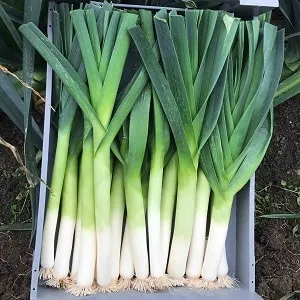
In the photo — the Columbus variety.
- Columbus – a Dutch variety with a pleasant, slightly sweet taste. The plant reaches 70-80 cm in height, the stem — 20 cm, diameter — 6 cm, weight — 400 g. Does not require hilling for stem whitening.
- Vesta – a high-yielding variety with a stem height of 150 cm, stem length — 30 cm, weight — 350 g. Excellent taste.
- Elephant’s Trunk – has a pleasant sweet taste and good shelf life. Stem height reaches 30 cm with frequent hilling.
- Goliath – features wide green or grey-green leaves, a whitened part of about 30 cm, diameter 6 cm, weight 200 g.
- Kilima – a highly productive early variety. The white part measures 10-25 cm, diameter — 3-4 cm, weight — 150 g.
Mid-season leek varieties are less productive than early ones but have better qualities. The maturation period is 150-180 days.
Distinctive features — wide blue-green leaves, stem weight — 200 g, height — 20-25 cm.
Best mid-season varieties:
- Jolant – resistant to fungal diseases and highly productive. Stem height is about 30 cm, the bulb is weakly expressed, leaves have an anthocyanin tint.
- Casimir – a tall, compact plant with high productivity, resistant to fungi. Leaves grow vertically from the stem, the bulb is weakly expressed, stem height — 25 cm, diameter — 3.5 cm.
- Camus – a medium-height plant. Leaves are concave, green with a waxy coating. Stem height — 20 cm, diameter — 2.5 cm.
- Tango – a frost-resistant, high-yielding variety with vertical leaves. Stem height — 12 cm, diameter — 5 cm, weight — 200 g.
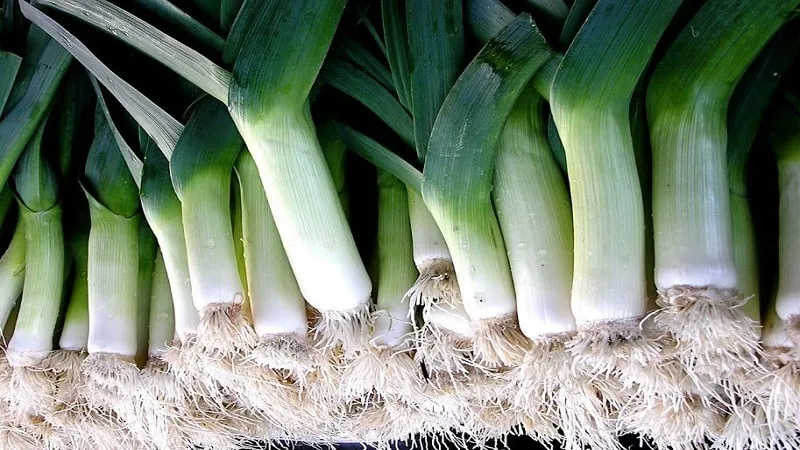
Late-season varieties take more than 180 days to mature, are highly productive, and store well. Leaves are blue-green with a waxy coating, densely arranged on the false stem at a 90° angle. The stem is short and thick.
Late-season leek varieties:
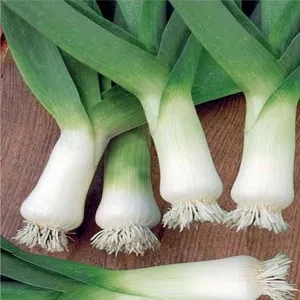
- Carantan – the white part is 25 cm tall, weight 200-300 g. Leaves are spreading, dark green.
- Elephant – a Czech variety, resistant to frost and drought. Has a slightly sharp taste. Stem height — 25 cm, weight — 200 g.
- Autumn Giant – a Dutch variety with a large white part, about 40 cm tall, diameter 7-8 cm. Stores well in a cellar.
- Asgeos – a frost-resistant variety with wide bluish-green leaves. Stem height — 20 cm, weight — 350 g. Taste is semi-sharp.
Growing Leeks in Open Ground
The crop has a long growing season — 150-200 days. Therefore, leeks are preferably grown through seedlings, especially in central and northern European regions. Sowing is done in mid-to-late February. Leeks require at least 10 hours of daylight, so early-sown seedlings are supplemented with grow lights.
In southern Europe, leek seeds are sown directly in the ground from mid-May.
An important condition for a good harvest is maintaining the right temperature. High temperatures at the seedling stage can cause the plant to bolt in the first year instead of the second.
Leeks grow best after potatoes, tomatoes, cucumbers, peas, beans, and cabbage.
Leeks are cold-resistant and can withstand frosts down to -5…-7°C. In regions with mild winters, the plant can remain in the open ground under snow cover. However, a rainy and cool summer leads to thin, short stems and loss of flavor.
Sowing Dates
Sowing dates vary depending on the climate of the region and the variety. Favorable dates from the lunar calendar are also considered.
Early varieties are sown in April, mid-season — late February to early March, late-season — late January to early February.
In northern Europe, seedlings are sown in April-May. In central regions with milder climates, sowing is done in mid-February. In southern Europe, leeks are sown directly in the ground in late May to early June.
Sowing dates according to the lunar calendar for 2024:
- January — 1, 5-9, 11, 14-16, 21, 22, 25, 29;
- February — 2-4, 10, 13-15, 17, 18, 20, 21, 24, 28, 29;
- March — 1, 3-5, 10, 11, 14-16, 18, 19, 21, 22, 29-31;
- April — 2-4, 6, 7, 9, 10, 14, 15, 23, 25, 27-29;
- May — 2, 3, 5, 6, 9, 12-14, 20, 22, 23, 25, 27-29;
- June — 1, 2, 4, 8, 11-13, 18, 19, 22, 24, 26-29.
Growing Seedlings
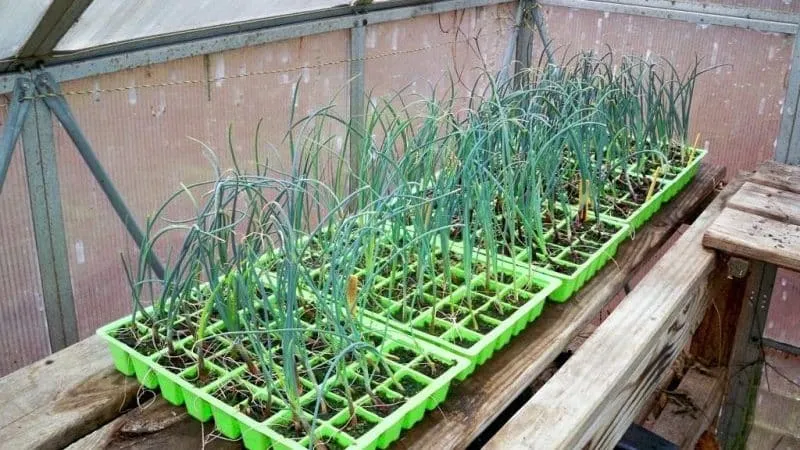
Sowing leeks as seedlings is the best way to ensure healthy plants and a good harvest. Seeds are pre-treated and soaked to improve germination. They are sown in trays or individual containers. Care includes watering, pricking out, fertilizing, and hardening outdoors.
Seed Preparation
Before sowing, seeds are soaked in warm water for 24 hours, then air-dried or placed in water at +40°C in a closed container for 3-5 hours. Afterward, they are rinsed and dried.
For disinfection, seeds are treated with a dark potassium permanganate solution or Biofungicide.
Soil Preparation
Loose, nutrient-rich soil is ideal for seedlings. Heavy, clayey soil is unsuitable, as it makes it difficult for sprouts to emerge.
Seeds are sown in ready-made substrate for cucumber, pepper, or eggplant seedlings, enriched with nutrients. Alternatively, you can prepare the soil yourself.
For a 10-litre mix, combine:
- peat, garden soil, compost (1:1:2);
- ash, crushed eggshells, peat, moss, sawdust, turf in equal parts.
The soil mix is pre-watered with a potassium permanganate solution or Biofungicide.
To reduce acidity, add a cup of wood ash. Alkaline soil is balanced with dolomite flour.
For fertility, use potassium salt, compost, urea, or superphosphate.
Any container can be used: tetra packs, plastic trays, boxes, or large cups. Containers are treated with hot potassium permanganate solution or boiling water.
Peat pellets are an excellent alternative to plastic trays. They simplify sowing — no need to prepare substrate. They maintain moisture levels, preventing soil from drying out.
Sowing
Sowing techniques vary depending on the container:
- in individual containers, place 3-4 seeds at 1 cm depth;
- in shared trays, sow one seed at 1-1.5 cm depth, spaced 4-5 cm apart;
- when sowing in a "snail," place seeds every 5 cm, 2-3 cm from the edge.
Containers are filled with moist substrate, and seeds are distributed. Cover with 0.5 cm of sand or peat, water, and wrap in plastic film. Seedlings are kept in a dark place at +21…+25°C until sprouts appear.
Sowing in a "Snail"
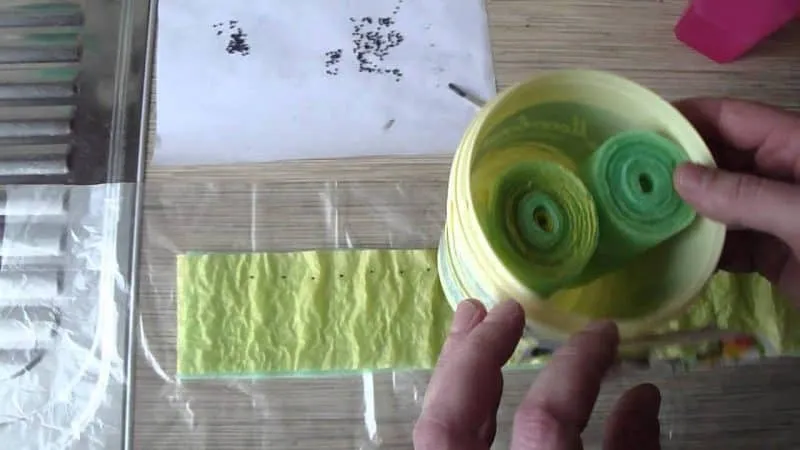
Sowing seeds in a "snail" is a proven method for strong, healthy leek seedlings.
Materials needed:
- laminate underlay or thick polyethylene strip (10 cm wide);
- soil mix;
- rubber bands;
- a tray larger than the roll.
Sowing steps:
- spread moist soil on the strip, leaving 2 cm from the edge;
- lightly press seeds into the soil, spacing 5 cm apart;
- roll the strip and secure with rubber bands;
- place the "snail" in a tray, seeds facing up;
- spray with water and cover with a plastic bag;
- after sprouts appear, remove the bag and move to a sunny windowsill.
Caring for Seedlings
Proper watering, temperature control, sufficient light, fertilizing, pricking out, and hardening ensure strong seedlings and a good harvest.
Watering
Leeks need frequent, abundant watering — 2-3 times a week. Young stems are delicate, so water carefully using a sieve or syringe at the base.
Misting keeps stems hydrated and removes dust.
Fertilizing
Seedlings are fertilized twice:
- 14 days after germination;
- 7 days before transplanting outdoors.
Use Universal Fertilizer or a mix of 5 g potassium chloride, 20 g superphosphate, and 10 g urea per 5 litres of water.
Chicken or quail manure is an excellent fertilizer. Mix 500 g manure with 10 litres of water and apply at the base.
Light and Temperature
After 2-3 weeks, once sprouts are strong, move containers to a glazed balcony for a week. Optimal temperature: +10…+12°C at night, +15…+17°C during the day. Then increase to +13…+15°C at night, +18…+20°C during the day until transplanting.
Light requirement: 12 hours. If sown in late January or early February, supplement with grow lights.
Pricking Out and Trimming
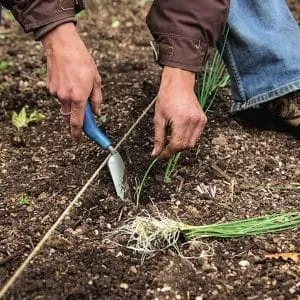
If sown in a shared container, seedlings are pricked out into individual cups. Carefully lift strong sprouts with a teaspoon and transplant into prepared cups with moist soil.
Add soil gradually as seedlings grow to form proper bulbs.
Trim stems every two weeks, maintaining a height of 10 cm. This promotes root development and thicker stems.
Note. Thin seedlings in shared containers after a month, leaving 3-4 cm between plants.
Hardening Off
A week before transplanting, take seedlings outside to harden. Place in partial shade. Start with 30 minutes, gradually increasing to 16 hours.
Transplanting to Open Ground
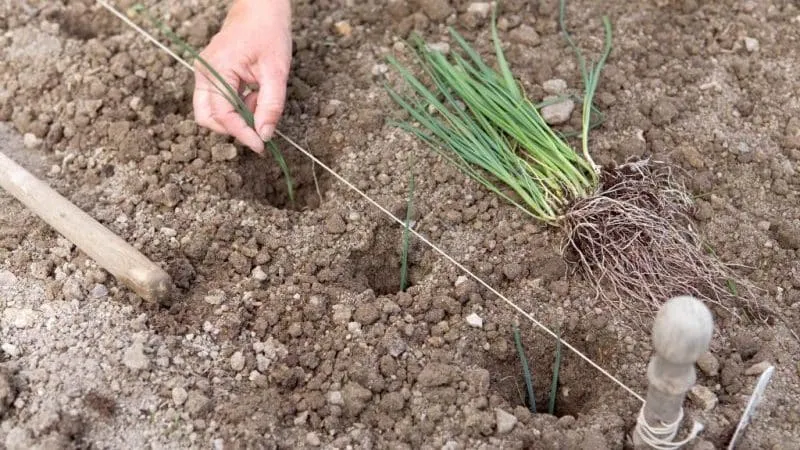
Transplant seedlings outdoors after the third leaf appears, around 55-56 days after germination. Before planting, trim roots and leaves by a third to encourage proper stem formation and faster rooting.
Prepare the plot in autumn or spring: deep ploughing, fertilizing with compost, marking beds.
Leeks grow best in neutral pH soil. To adjust acidity, add lime or dolomite flour (400–500 g per sq. m).
Note. Avoid planting leeks in the same spot more than once every three years.
Before planting, dip roots in a clay-and-manure mix (1:1) for better establishment.
Plant seedlings in 10-13 cm deep furrows, spaced 15-20 cm apart. Row spacing — 35-45 cm. Add a nutrient mix — 10 litres compost, 0.5 litres wood ash.
Ongoing Care
Leek care guidelines:
- Water beds with settled water (10 litres per sq. m) every 4-5 days, increasing frequency in drought. Keep soil consistently moist but not waterlogged. Initially, water to 7-10 cm depth.
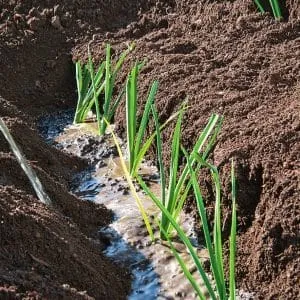
- Hill seedlings every two weeks to blanch stems and enhance flavor.
- Loosen soil after each watering. Remove weeds as they grow.
- Mulch with sawdust, hay, or straw to reduce weeding.
- Fertilize with a manure solution: 1 part manure, 20 parts water, 35 parts superphosphate.
Diseases and Pests
Leeks are susceptible to viral mosaic, which is untreatable. The vector is melon aphids.
Symptoms appear after transplanting: yellow longitudinal spots on stems, stunted growth.
Fungal diseases like rust (yellow pustules) and downy mildew (dry leaf tips, white/grey leaves) occur. Treat with copper oxychloride (40 g per 10 litres) or Biofungicide (5 g per 10 litres).
Prevention:
- weed control;
- pest management;
- crop rotation;
- planting resistant varieties;
- seed disinfection;
- removing infected plants.
Leek moth is a major pest.
Control methods:
- dust with wood ash (300 g per sq. m), ash-tobacco mix (1:1), or red pepper (2 tsp per sq. m);
- spray with tobacco infusion (200 g tobacco in 10 litres hot water, steep 12 hours, add 50 g soap shavings).
Harvesting and Storage
Harvest before the first frost. Leeks tolerate frosts down to -7°C. Dig up with a spade and dry on beds.
Trim roots and store in a cellar. Do not cut leaves, or plants will wilt.
Optimal storage: -1…+1°C, 80-85% humidity. Place in boxes with 5 cm damp sand, stems upright. Stores for 6 months. Alternatively, store on a glazed balcony.
For fridge storage, trim leaves and roots, place 6-8 stems in perforated bags. Store at -5°C for 4-5 months.
Freeze chopped leeks in 5 cm layers in bags.
Conclusion
Growing leeks from seedlings ensures harvest before hard frosts. Sowing dates depend on the lunar calendar and regional climate. In northern Europe, sow in late January; in southern regions, sow directly in May. Central Europe sows in March-April.
Leeks need ample water, hilling, weeding, fertilizing, and protection from diseases and pests. Wishing you a healthy and bountiful harvest!







